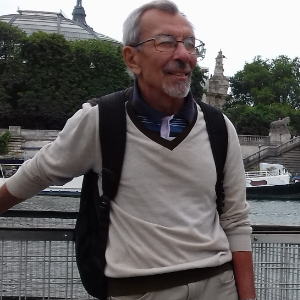Title : Multi scale optimization of several coaxial disks targeted on maximal Q-factor
Abstract:
We perform optimization of Q-factor in the system of freestanding three/four/five/six coaxial subwavelength dielectric disks over all scales. Each parameter contributes almost one order of magnitude of the Q-factor due to multiple avoided crossings of resonances to give totally the unprecedented values for the Q-factors: 6.6 x104 for the three, 4.8 x106 for four, 8.5 x 107 for five and one billion for six free standing silicon disks. By multipole analysis of the resulting hybridized resonant mode we observe that such extremely large values of the Q-factor are attributed to strong redistribution of radiation that originates from almost exact destructive interference of dominating complex multipole radiation amplitudes.The underlying idea for optimization of the Q-factor is based on the following. The system of N free standing coaxial disks offers 3N-1 scales to vary in general, N radii r_j, N heights h_j, j=1, 2, …, N, and N-1 distances L12, L23, …, LN-1,N. Accounting that one of the scales is to be chosen for dimensionless ratios, we obtain totally 3N-2 parameters. It is reasonable to assume that symmetrical structures could radiate less compared to non-symmetrical structures. Then in frame of this assumption (3N-1)/2 free parameters are left to vary as shown in Figure on example N=6. To boost the Q-factor we perform optimization procedure in parametric space for initial sets of parameters. Assume we reach maximal Q-factor for inner sub system of N-2 disks.Then varying remaining scales L12= LN-1,N, r1=rN, h1=hN of outer dimer we realize avoided crossing of resonances of inner subsystem and outer dimmer to result further enhancement of Q-factor. Finally slight detuning of parameters of inner subsystem gives rise to unprecedented results substantially exceeding examples of whispering gallery modes or quasi bound states in the continuum in periodical array of N disks
Audience Take Away Notes :
- The audience will learn the phenomenon of an avoided crossing of resonances with complex frequencies under multi scale variation of all scales in the system of N resonators. That enormously enhances the Q factor of sub wavelength dielectric resonators.
- Besides fundamental interest in research engineering of extremely high Q factor by variation of parameters of two, three, etc dielectric resonators by means of avoided crossing of resonances of isolated resonator provides a practical solution to a problem ultra-high Q factor resonant systems. That paves new ways to sensing, lasing, etc


